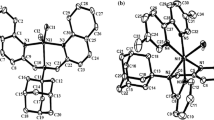Conclusions
-
1.
The industrial catalyst Ni/kieselguhr with 50% Ni catalyzes the reduction of p-chloronitrobenzene to p-chloroaniline in an autoclave under a pressure of 50–100 atm with a yield of up to 99% under optimum conditions. The catalyst is deactivated during operation as a result of of the influence of the HCl partially formed upon it.
-
2.
When this catalyst is used in a flow-type apparatus under atmospheric pressure, it is found that under optimum conditions the reaction proceeds to an extent of 64% with 0.8% splitting out of HCl.
-
3.
An investigation of powdered nickel as a catalyst for the reduction of p-chloronitrobenzene indicated that when experiments are conducted in an autoclave it is inactive, while in a flow-type apparatus at atmospheric pressure, up to 88% p-chloroaniline can be obtained with 0.4–0.9% splitting out of HCl.
-
4.
An alloy of Ni — Cu (1 ∶ 1) proved inactive for the investigated reaction when the experiments were conducted in an autoclave; in a flow-type catalytic apparatus at atmospheric pressure, the yield of pchloroaniline did not exceed 25%.
Similar content being viewed by others
Literature cited
A. M. Popov, Anilinokrasochnaya Promyshlennost',3, 391 (1933).
A. A. Balandin and A. N. Titova, Uch. Zapiski MGU,2, 229 (1934).
C. F. Winans, J. Amer. Chem. Soc.,61, 3564 (1939).
Tsutomu Sasa, J. Soc. Organ. Synt. Chem.,12, 183 (1954).
Kiyoshi Hoizumi and Tatsuo Yamanaka, Kagaku Kénkyudzë Khokoku,32, 164 (1956).
B. E. Leggetter and R. K. Brown, Canad. J. Chem.,38, 2363 (1960).
Shigeru Tsutsumi and Shiro Nagao, J. Chem. Soc. Japan, Ind. Chem. Sect.,54, 371 (1951).
A. A. Strel'tsova and N. D. Zelinskii, Izv. AN SSSR, Otd. Khim. N.,1941, 401.
L. Hernandez and F. F. Nord, Experimentia,3, 489 (1947).
L. Hernandez and F. F. Nord, J. Coll. Sci.,3, 363 (1948).
F. C. Trager, US Patent 2,772,313 (November 27, 1956); Chem. Abstrs.,51, 10570f (1957).
W. P. Dunworth and F. F. Nord, J. Amer. Chem. Soc.,74, 1459 (1952).
W. P. Dunworth and F. F. Nord, J. Amer. Chem. Soc.,72, 4197 (1950).
E. I. du Pont de Nemours, Great Britain Patent 859,251 (January 18, 1961); Chem. Abstrs.,55, 21051b (1961).
Hsien-Cheng Yao and P. H. Emmett, J. Amer. Chem. Soc.,83, 796 (1961).
B. O. Pray and F. G. Trager, US Patent 2,791,613 (May 7, 1957); Chem. Abstrs.,52, 1226h (1958).
H. C. Brown and K. Sivasankaran, J. Amer. Chem. Soc.,84, 2838 (1962).
L. W. Covert and H. A. Adkins, J. Amer. Chem. Soc.,54, 4116 (1932).
H. Adkins and H. R. Billica, J. Amer. Chem. Soc.,70, 695 (1948).
R. Schrader, H. Grund, and G. Tetzner, Z. Chem.,3, 356 (1963).
K. Ellis, Hydrogenation of Organic Compounds [Russian translation], ONTI, Goskhimtekhizdat,1 (1934), p. 148.
Author information
Authors and Affiliations
Additional information
Translated from Izvestiya Akademii Nauk SSSR, Seriya Khimicheskaya, No. 11, pp. 1885–1891, November, 1966.
Rights and permissions
About this article
Cite this article
Sokolova, N.P., Balandin, A.A., Maksimova, N.P. et al. Catalytic reduction of chloronitrobenzene to chloroanilines. Russ Chem Bull 15, 1824–1829 (1966). https://doi.org/10.1007/BF01179687
Received:
Issue Date:
DOI: https://doi.org/10.1007/BF01179687




